For the team here at Sissinghurst it’s felt like a good summer, with plenty of sunny warm days, and enough rain to keep things healthy. After a slow start the insect life has been good too, and there seem to have been lots of bees about. Many visitors to the garden will have seen that we have hives in the orchard, so how has the season been for our resident bees?
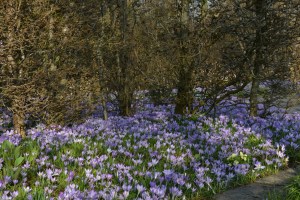
Spring and the Crocus thomasinianus provides the first nectar
I have been the main beekeeper at Sissinghurst for two seasons now, and have started at the time when the learning curve has been like a rollercoaster. Last year was very bad for them, and this year has been odd and unpredictable. We started the season with a strong colony in one hive, and healthy but small one in the other. I was pleased that both had made it through the winter, when many keepers had lost more than 50% of theirs, so it was a good start. The garden at Sissinghurst is abundant with flowers, and of particular importance is the early spring flush which provides and bounty of nectar for the bees when there is little else about; everything was going nicely.
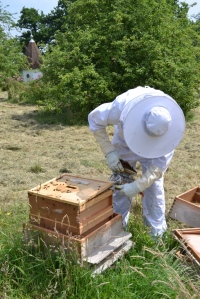
Opening up the hive for a routine inspection, with a gentle puff of smoke
The role of beekeeping requires much routine, and we can often be observed doing one of the weekly inspections. Wearing our suits we smoke the bees, and then open up the hives, which at Sissinghurst are WBC type (twin walled, traditional, durable). On the top are ‘supers’, which are boxes with frames of hexagonal foundation, that the bees build up with wax and then fill with honey. The ‘supers’ fill throughout a good season and are pure honey, with the queen being kept from theses sections by a queen excluder. Below the ‘supers’ and the excluder is the ‘brood’ box, which is larger, and again full of frames. The queen can be found in this section, and lays her eggs here, but has open access to fly. It’s the brood box that we focus on for the inspection, and we go through each frame to determine the vitality of the colony.
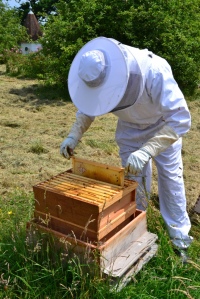
Here the ‘super’ can be seen containing frames of honeycomb…
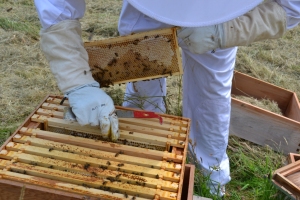
…and here, more closely, with a frame removed. Some of the honey is capped
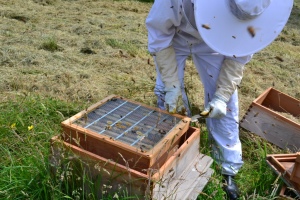
Below the ‘super’ is the queen excluder, with the brood box below
So what are we looking for? The ideal brood box will have hexagonal comb, some open with either eggs or small larvae, and some capped with developing larvae. Around the outside will be honey stores, and are enough for the colony to over-winter (making the super surplus). If that’s all we see then we know the colony is performing well, but we try each time also to spot the queen, and that is not so easy. In our strongest colony I’ve yet to see her, but I know she is there due to the signs, but in our nursery colony she is marked, and I see her most times.
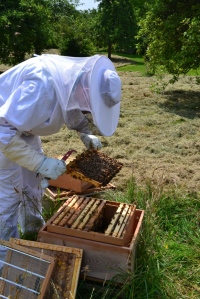
Closely inspecting the brood
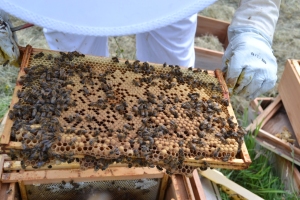
On this brood frame can be seen capped and un-capped cells. The large caps contain drones (males)
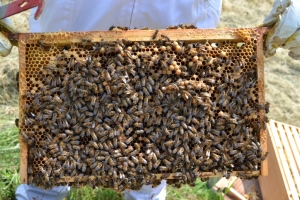
A busy frame – hard to spot a queen…can you?
Until July all seemed well, the strong colony had filled a super, and was starting the next, and the young smaller one was becoming strong, so they were given a super. I then went on holiday for two weeks and returned to find that the latter had no queen. Where had she gone? Swarming is not uncommon, but usually there is a new queen brought by the workers. There were fewer bees so a swarm was likely, and there was an empty queen cell showing a new one had emerged and also flown. By mid August it was clear that a new queen was not present, and it was too late to add another, so I planned to unite these bees with another colony. Just before this happened we had a wasp attack, which wiped out the colony and removed all the honey, making my healthy colony a dead one.
It’s not all been bad however, as the other colony is still very healthy and has just produced 21lbs of honey, which is not bad for out first harvest. We have many worried questions when inspecting them in the garden about the plight of bees, and the answer feels simple to me. Whilst unpredictable, just like us and any other creature, bees that are treated well and with respect will be strong, healthy and endure.
Matt – Garden & Estate Manager
Glad to hear the bees and the beekeeper are doing well!!! Sissinghurst is indeed a fantastic, natural and healthy place for bees (and not only for bees…) I remember there is also a colony in the wall of the library and sometimes in the tower…Let it be! Greetings from a Belgian beekeeper.
LikeLike
Good to hear from a friend accross the water. Our wild wall dwelling colonies have indeed been here all summer too, swarming occasionally and giving us some fun.
LikeLike